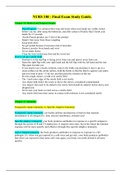Exam (elaborations)
NURS 100 - Final Exam Study Guide (100% correct).
- Institution
- West Coast University
NURS 100 - Final Exam Study Guide (100% correct)/NURS 100 - Final Exam Study Guide (100% correct). Chapter 10: Medical and Surgical Asepsis Hand Hygiene: Use antimicrobial soap and water when your hands are visibly soiled, before you eat, after using the bathroom, and after contact of bodi...
[Show more]



